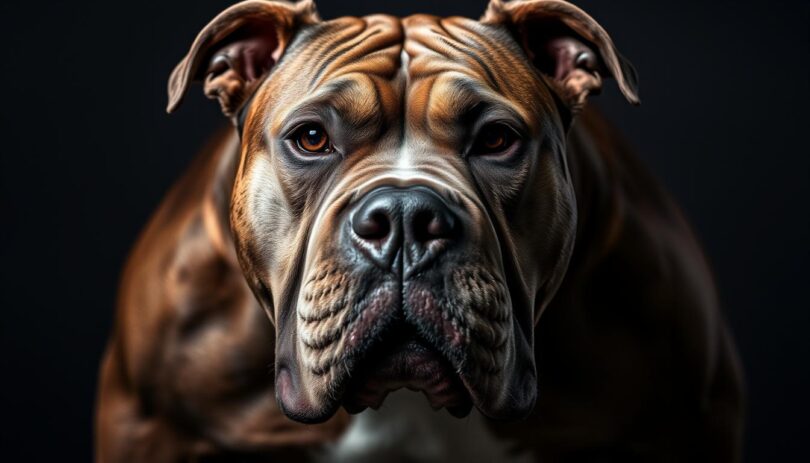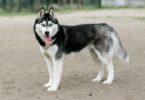What if everything you thought about certain dogs was shaped by centuries-old myths? Can a group of canines once bred for strength and tenacity truly transform into affectionate family members? This article explores the fascinating journey of these muscular companions – from ancient working roots to modern-day couch cuddlers.
Originating from molosser-type ancestors, these powerful dogs were historically valued for their physical prowess. Their broad chests and square-shaped heads reflect generations of selective breeding for tasks like guarding and bull-baiting. Yet behind their imposing appearance lies a complex story of adaptation.
The term “bully” itself comes from their bull-catching history, not temperament. Modern versions have evolved far beyond their ancestors’ roles. Today, many excel as therapy animals and loyal household members, disproving outdated stereotypes through gentle behavior and emotional intelligence.
This guide examines their unique characteristics, care needs, and legal considerations. You’ll discover how proper training unlocks their potential as devoted pets. Whether you’re considering adoption or simply curious, we’ll separate fact from fiction about these often-misunderstood canines.
Discovering the Origins and History of Bully Breeds
Long before these dogs became household names, their ancestors roamed ancient battlefields and farms. Powerful Molossers from Greece guarded livestock as early as 500 BCE, showcasing strength that would shape future generations. These thick-bodied canines laid the groundwork for traits seen in modern pit bull-type dogs.
Ancient Molossers and Bull-Baiting Roots
Medieval Europe transformed these protective dogs into participants in brutal sports. Bull-baiting became widespread by the 1500s, with dogs gripping bulls’ noses to entertain crowds. This practice directly influenced the term “bully,” derived from their bull-facing role rather than behavior.
When England banned blood sports in 1835, breeders shifted focus. They crossed bulldogs with terriers, creating agile yet muscular dogs for ratting contests. This marked the beginning of what people now recognize as pit bull terriers.
The Evolution in the United States
Immigrants brought bull-and-terrier dogs to America in the 1800s. Farmers valued their versatility for herding and protecting homesteads. By the 1930s, kennel clubs began recognizing distinct types like the American Staffordshire Terrier.
Modern breeding practices emphasize temperament over aggression. The American Pit Bull Terrier gained popularity as a loyal companion, while new variations like the XL American Bully emerged in the 1990s. These changes reflect how people reshaped working dogs into family-focused pets through selective breeding.
Understanding Bully Breeds: Physical Traits and Unique Appearances
What makes these canines instantly recognizable at first glance? Their striking physical features combine power and symmetry, creating a look that’s both imposing and endearing. While sizes vary, certain structural hallmarks tie these dogs together across different lineages.
Muscular Builds and Sturdy Frames
Broad shoulders and deep chests give these dogs a barrel-like silhouette. Developed through centuries of selective breeding, their compact bodies prioritize strength over speed. Thick necks flow into well-defined limbs, allowing them to excel in activities requiring bursts of energy.
This robust structure traces back to Molosser ancestors used in ancient Greece. Modern versions retain that solid foundation while adapting to less physically demanding roles. Even smaller varieties maintain proportionally dense muscle mass beneath smooth coats.
Square-Shaped Heads and Distinct Facial Features
A wide, flat forehead paired with a short muzzle creates their signature facial profile. Expressive eyes sit beneath wrinkled brows, often giving them an alert yet approachable look. Strong jaws – once essential for gripping – now serve as playful tools for carrying toys.
Despite differences in ear shape or coat color, most share a squared head shape. This consistency helps identify them across breeds like the American Staffordshire Terrier. Their unique faces blend functionality with charm, making each dog memorable in its own way.
Bully Breeds: Characteristics and Temperament
Many are surprised to discover the true personality behind these muscular companions. Modern studies reveal a temperament combining steadfast loyalty with joyful enthusiasm—a stark contrast to outdated stereotypes. Properly raised dogs often become sensitive family members who thrive on human connection.
Loyalty, Affection, and Protective Instincts
These canines form unshakable bonds with their households. Their watchful nature makes them attentive guardians, often alerting families to unfamiliar activity. Yet their protective streak coexists with gentle affection—many prefer cuddling on couches over patrolling yards.
Early socialization channels their instincts positively. When trained with patience, they become dependable companions who read household moods intuitively. Their history as working partners translates into a deep desire to please their people.
Playfulness and Social Adaptability
Bursts of energy define their play style, often involving enthusiastic games of fetch or tug-of-war. Regular interaction helps maintain their cheerful disposition. Structured activities provide mental stimulation while reinforcing boundaries.
Well-socialized dogs adapt smoothly to various environments, from bustling parks to quiet homes. Their intelligence shines during training sessions, especially when rewarded with praise. This balance of discipline and fun creates adaptable pets suited for diverse lifestyles.
Popular Bully Breeds You Should Know
From athletic companions to compact city dwellers, these muscular dogs showcase remarkable diversity. Each brings distinct traits shaped by generations of selective breeding, yet all share the sturdy build and loyalty of their Molosser ancestors.
American Staffordshire Terrier & Bull Terrier
The American Staffordshire Terrier combines strength with sensitivity. Standing 17-19 inches tall, this staffordshire bull descendant thrives in competitive sports. Its broad skull and muscular frame hide a playful spirit that bonds deeply with families.
Bull Terriers turn heads with egg-shaped skulls and triangular eyes. Originally bred for vermin control, these 50-pound dogs channel energy into clownish antics. Their “pit bull” lineage shows in tenacious play styles, balanced by gentle affection for trusted humans.
French Bulldog & Miniature Bull Terrier
Urban dwellers adore the French Bulldog for its adaptability. Bat-like ears and a smooshed face define this 20-pound charmer. Despite minimal exercise needs, its protective streak and comical snorts make apartments feel lively.
The Miniature Bull Terrier packs big personality into 14 inches. Developed from staffordshire bull stock, this compact version excels at agility. Wrinkled foreheads signal mischief – perfect for owners wanting energetic, laugh-filled companionship.
While sizes vary from 12-pound Frenchies to 70-pound Staffies, all share common roots. Their square jaws and sturdy builds reflect historic roles, now channeled into modern devotion. Proper training helps each shine as loyal partners.
Caring for Your Bully Breeds: Training, Exercise, and Socialization
Raising a strong, energetic dog requires understanding their unique needs. Three pillars shape a well-adjusted companion: structured training, physical activity, and positive social experiences. Owners who master these elements often discover remarkably adaptable pets beneath the muscular exterior.
Positive reinforcement works best for teaching commands. Reward good behavior immediately with treats or praise—this builds trust faster than harsh corrections. Clicker training helps mark desired actions precisely, while 10-minute sessions keep focus sharp. Consistency turns lessons into lifelong habits.
Daily exercise prevents boredom and supports joint health. Aim for 60 minutes of walks, fetch, or obstacle courses. Mental stimulation matters too—food puzzles challenge problem-solving skills. A tired dog is a happy dog, less likely to chew furniture or dig holes.
Socialization starts young. Introduce new people, animals, and environments between 3-16 weeks old. Supervised playdates teach polite interactions. Reward calm behavior around strangers to reduce anxiety. Well-socialized dogs adapt better to vet visits or crowded parks later in life.
Modern tools like GPS collars and treat-dispensing cameras add convenience. But nothing replaces hands-on bonding through training and play. Proactive owners who invest time early reap rewards for years—loyal companions who thrive in family settings.
Health Considerations and Nutritional Needs
Muscular companions thrive when owners understand their biological requirements. Though often perceived as rugged, these dogs benefit from specialized care to maintain vitality and prevent hereditary conditions.
Common Health Issues in Muscular Dogs
Joint dysplasia ranks among top concerns, causing stiffness during walks or play. Proper calcium ratios in food support bone development, while low-impact activities like swimming reduce strain. Allergies frequently trigger skin irritation, managed through diets featuring novel proteins like duck or salmon.
Obesity shortens lifespan significantly. High-protein meals with limited carbs help maintain lean muscle mass. Dental health improves with raw food options that naturally scrub teeth, reducing plaque buildup common in middle-aged dogs.
Regular vet visits catch issues early. Bloodwork monitors thyroid function, while eye exams track cataract development linked to aging. Owners should watch for excessive scratching or limping – early intervention improves outcomes.
Tailored exercise routines balance energy release with joint protection. Short, frequent walks prevent overheating in warm climates. Mental stimulation through puzzle feeders complements physical activity for holistic health.
Despite their tough reputation, these pets require thoughtful nutrition. Omega-3 supplements combat inflammation, while probiotics enhance digestion. Quality care transforms potential health challenges into manageable aspects of pet ownership, ensuring years of joyful companionship.
Legal Considerations and Community Perspectives on Bully Breeds
Owners of strong, loyal dogs face unique challenges shaped by laws and public opinion. Over 30 U.S. states enforce breed-specific legislation (BSL), restricting or banning certain types based on appearance rather than behavior. These laws create hurdles for families seeking to adopt muscular companions.
Understanding Breed-Specific Legislation
BSL targets dogs with specific physical traits, often labeling them “dangerous” without individual assessments. Miami-Dade County banned pit bulls in the 1980s, while Denver prohibited them entirely until 2021. Such rules force owners to navigate insurance hurdles or relocate to pet-friendly areas.
Media portrayals fuel misconceptions, linking these dogs to urban crime or irresponsible ownership. Studies show BSL enforcement often overlaps with racially diverse neighborhoods, deepening social divides. Yet 73 U.S. cities have repealed such laws since 2018, reflecting shifting attitudes.
Responsible ownership helps combat stigma. Leash laws, sterilization programs, and training classes prove more effective than breed bans. Advocacy groups promote education over restriction, highlighting how proper care transforms loyal pets into cherished family members.
While challenges persist, growing support for fair treatment reshapes the legal landscape. Illinois and Nevada now bar insurers from denying coverage based solely on breed. This progress underscores the importance of judging dogs by their actions—not their ancestors’ history.
Exploring the Extended Family of Bully Breeds
The world of muscular canines extends far beyond familiar names. Many share the same ancestral roots while showcasing unique adaptations. Let’s meet some remarkable relatives in this diverse canine clan.
Additional Breeds with Shared Traits
Boxers bring athleticism and affection to the family tree. Their square jaws and playful energy mirror traditional types, though they stand taller at 21-25 inches. Cane Corso dogs offer imposing stature with ancient guardian instincts, often weighing over 100 pounds.
The American Bully emerged through careful crossbreeding. This modern variation combines pit bull tenacity with bulldog calmness. Smaller than traditional working dogs, they excel as companion animals while retaining protective instincts.
Versatile Roles in Modern Life
From Dogo Argentinos assisting in search missions to Boston Terriers snuggling in apartments, these canines fill countless roles. French Bulldogs prove even compact builds can house big personalities – their comical antics make them ideal city pets.
Despite size differences, most share common threads. Loyalty remains central, whether guarding estates or comforting children. Proper training helps each type shine in their chosen purpose, from service work to competitive sports.
Final Thoughts on Living with Bully Breeds
Embracing life with these powerful companions requires both heart and knowledge. Once bred for challenging tasks, today’s versions thrive as devoted family members when given structure and care. Their journey from historical working roles to modern couches proves how environment shapes behavior.
These dogs form extraordinary bonds with their people, often becoming intuitive protectors and playful confidants. Successful ownership means committing to consistent training, early socialization, and preventive healthcare. Like any pet, they flourish when families understand their physical needs and emotional intelligence.
Modern ownership also demands awareness of local laws and insurance requirements. While outdated stereotypes persist, informed caregivers can challenge misconceptions through responsible practices. Proper guidance transforms potential challenges into opportunities for growth.
Choosing to share your home with these loyal companions isn’t just about adopting a dog—it’s joining a partnership built on mutual trust. With patience and education, families discover a fulfilling relationship that enriches daily life. The reward? A devoted friend who redefines what it means to belong.
FAQ
Are bully breeds naturally aggressive?
No. Breeds like the American Staffordshire Terrier and Bull Terrier are known for loyalty and affection when properly socialized. Their behavior often reflects training, environment, and owner responsibility.
What physical traits define bully-type dogs?
These dogs typically have muscular builds, broad chests, and square-shaped heads. Distinct facial features, such as pronounced jawlines and expressive eyes, are common in breeds like the French Bulldog.
How much exercise do bully breeds require?
Most need 30–60 minutes of daily activity. Breeds like the American Pit Bull Terrier thrive with playtime and mental challenges, while French Bulldogs prefer shorter walks due to their brachycephalic nature.
What health issues affect these dogs?
Hip dysplasia, skin allergies, and breathing problems (in short-nosed breeds) are common. Regular vet checkups and a balanced diet help manage risks for breeds like the Staffordshire Bull Terrier.










Leave a Comment